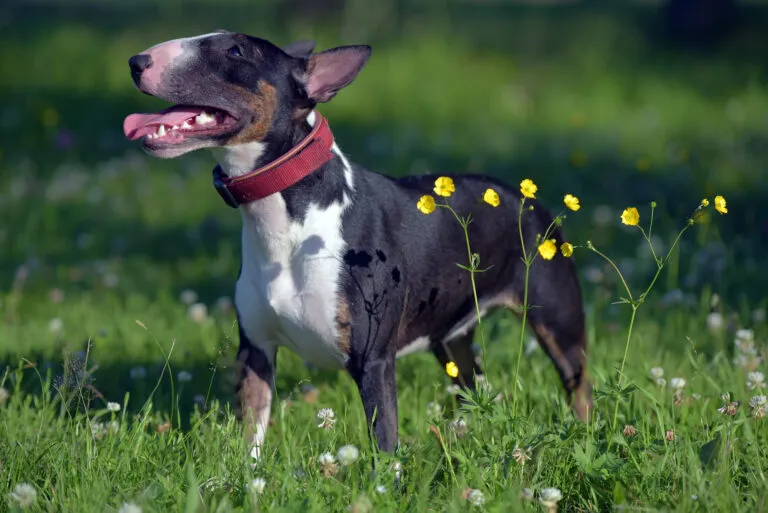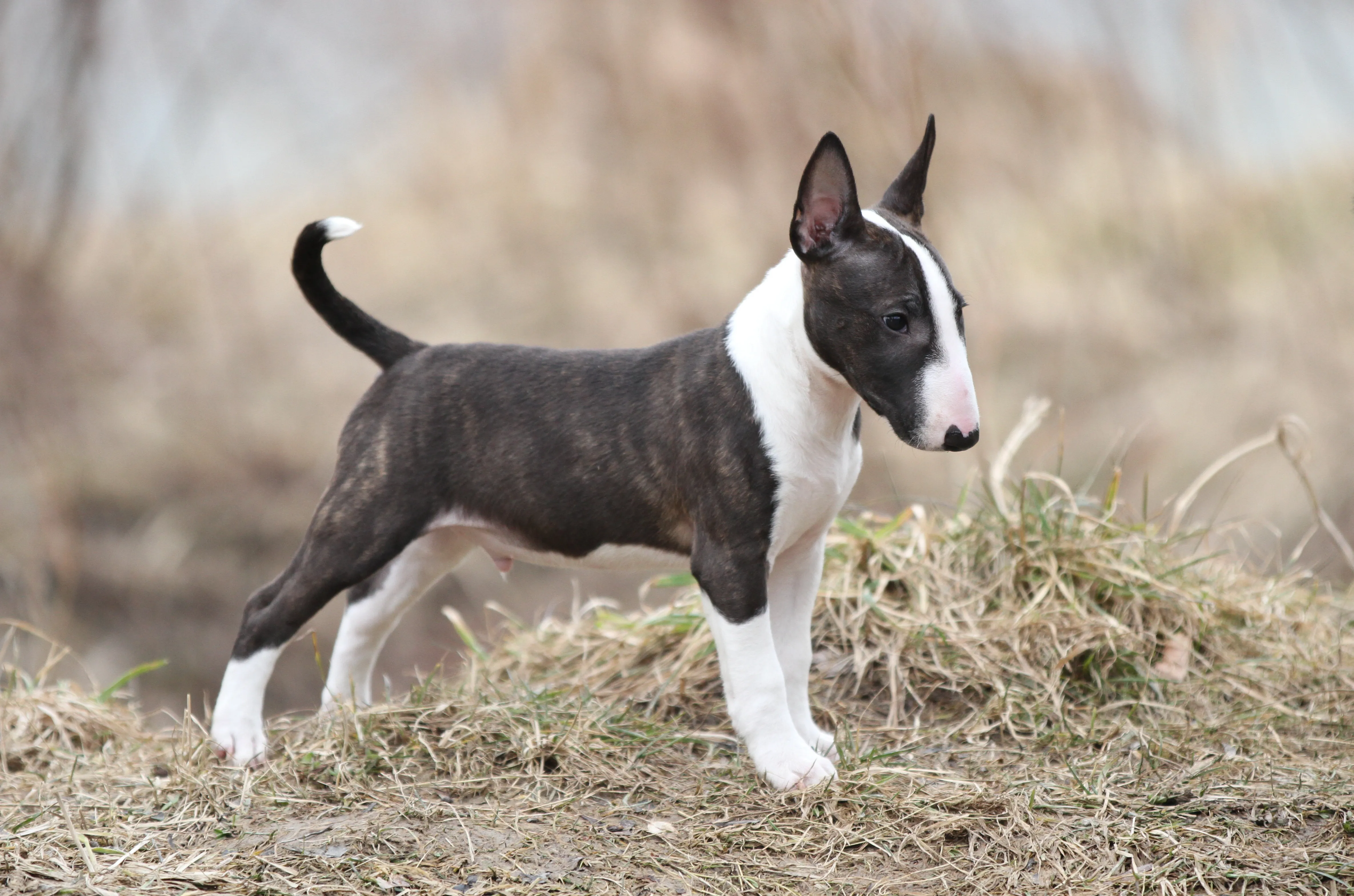Medium Size Poodle
With its distinctive "downface," egg-shaped head, and determined expression, the Miniature Bull Terrier is a smaller version of its "big brother," the Standard Bull Terrier. Early socialisation and consistent training can shape this little one into a balanced and loyal family dog that gets along well with children and cats.

© Evdoha / stock.adobe.com
The Miniature Bull Terrier is a lively yet gentle companion that enjoys outdoor adventures and gets along well with children
Despite being bred as an independent breed for almost 150 years, many people still see it as just a miniature version of the Standard Bull Terrier. It’s no surprise then, that the little one sometimes suffers from the negative reputation of its larger counterpart as an “aggressive fighting dog.”
However, a closer look reveals a different story – just like with the Standard Bull Terrier.
Despite its undeniably brave and lively nature, the Miniature Bull Terrier is exceptionally balanced, friendly and playful. It’s particularly gentle and disciplined when interacting with children. With an extremely high threshold for irritation, it won’t be easily bothered by a noisy group of kids.
This certainly doesn’t mean it will just laze around in its basket – on the contrary, the Miniature Bull Terrier is always ready for a romp and play. Forever on the hunt for new adventures, it eagerly follows its human companions outdoors.
Though not destined to be a top athlete, it loves long walks, varied paths, exciting games and silly frolics.
As passionate as it is about activities and movement, it equally enjoys relaxing and cuddling with the family. In search of affection and attention, this little dog follows its human everywhere. It does not cope well with being left alone for long periods.
Being so focused on its humans, neglect or rejection can often lead to depression or even aggression. Despite its close bond with the family, the Miniature Bull Terrier is quite headstrong.
Don’t expect blind obedience; this little – sometimes rather stubborn – personality has its own mind.
The Miniature Bull Terrier’s unique head shape, with its egg-shaped “downface,” is unlike any other in the dog world. The straight line formed by the forehead and nose is a distinctive feature for both the Standard and Miniature Bull Terrier.
The Miniature Bull Terrier shares the robust, muscular and compact body of its “big brother.” The short, smooth and close-fitting coat emphasises its harmonious proportions. Unlike the Bull Terrier, where the breed standard does not specify weight or size, the Miniature has a max. shoulder height of 35.5cm.
There are no weight specifications, but the breed standard requires the weight to be in a balanced proportion to the body size. Be careful not to confuse the required “maximum substance” of the Miniature Bull Terrier with overweight.
The Miniature Bull Terrier is available in various colours – an indication that the breed was initially bred for its working ability as a rat and mouse hunter rather than for appearance. You can find pure white, black, red, fawn or brindle specimens.
Two or three-coloured dogs are also allowed, with the base colour being more dominant. For white dogs, only head markings are permitted; spotting in the rest of the fur is undesirable. Blue or liver brown colours are also rejected.
 © Petra Eckerl / stock.adobe.com
© Petra Eckerl / stock.adobe.com
Like the Standard Bull Terrier, the Miniature Bull Terrier originated in England in the 18th and 19th centuries. Bulldogs and Terriers are among the ancestors of both breeds. Despite these shared origins, the Miniature is not just a “copy” of the Standard Bull Terrier.
Also known as the Toy Bull Terrier, the Miniature Bull Terrier has been bred independently for over 150 years, even though the two breeds were sometimes crossbred, especially in the difficult years following World War I.
In its early years, the Miniature Bull Terrier was primarily bred for hunting rats, mice and martens, but also as a diligent and friendly companion. In England’s industrial areas, it was also used for bloody dog fights, valued for its speed and boldness. During this period, there were many variants, some of which bore little resemblance to the modern breed.
The characteristic elongated, convex snout and egg-shaped head developed later, primarily through the work of English animal dealer James Hinks. A specimen displaying these typical features was first exhibited in 1862.
In the following years, especially during World War I, the number of registered Miniature Bull Terriers decreased dramatically. In 1918, the breed was removed from the Kennel Club Register, with the breed being 98 percent extinct. The remaining Miniature Bull Terriers were listed as Standard Bull Terriers and crossbred with the smallest specimens of that breed.
An English breeders’ group led by Colonel Richard Glyn sought to reverse this trend. They succeeded, establishing the Miniature Bull Terrier Club in 1938, achieving renewed recognition by the British Kennel Club shortly thereafter. The Fédération Cynologique Internationale (FCI) formally recognised the breed in July 2011, listing it under standard number 11 in Group 3 (Terriers), Section 3 (Bull-type Terriers).
The Miniature Bull Terrier is still a rare breed, a circumstance which may be advantageous for its health. Unlike the Standard Bull Terrier, which is prone to umbilical hernia, deafness, tumours, heart and circulatory diseases, and kidney and joint problems, the health of this robust Miniature is quite stable.
Nevertheless, it is crucial to monitor health risks. If you opt for a puppy from a breeder, make sure to review the health test results. These should include information on the health of the heart, eyes, kidneys, kneecap (patella) and especially the hearing abilities of the parents and offspring.
One health issue is the requirement for a pure white coat, which stems from a genetic defect that often leads to deafness. If the health of your Mini is more important than the colour, it’s wiser to avoid purchasing a pure white puppy.
Keeping your Miniature Bull Terrier healthy depends not only on its genetic traits. As an owner, you also play a significant role in its wellbeing. Providing appropriate care and a healthy, balanced diet ensures that your four-legged friend always feels fit and lively.
Remember, the breed tends to gain weight easily. Food quantities should match your dog’s body size. Stick to regular feeding times and avoid too many treats between meals.
If you do offer treats, include them in the daily food allowance. For instance, if your dog has had several treats in the afternoon, its dinner portion should be smaller.
Adult dogs primarily consume meat. Side dishes include vegetables or rice. Foods should be of high quality and ideally fresh. A good way to keep your Mini healthy is BARF (Biologically Appropriate Raw Food), where your pet receives untreated, raw foods with no chemical additives.
However, you can also feed your dog industrially produced dry or wet food for a balanced diet. The key is to understand the ingredients and ensure they meet your dog’s nutritional needs. The source of meat and ingredients should be clearly listed on the packaging.
Avoid commercial pet food that contains a high amount of grain, artificial flavour enhancers, chemical preservatives or sweeteners like sugar.
Thanks to its short, smooth coat, caring for the Miniature Bull Terrier is relatively easy. To maintain the shine of its dense coat, brushing once a week is sufficient. If a bath becomes necessary due to heavy dirt, use dog shampoo sparingly.
Frequent shampooing can cause skin irritation. Besides weekly coat care, regularly check your dog’s ears, nails and teeth. Trim the nails as soon as you can hear them clicking on the floor.
Anyone considering bringing a Miniature Bull Terrier into their home should be aware that handling this breed requires a lot of time. While they may seem low-maintenance regarding care and nutrition, they demand significant attention and interaction daily.
Minis are extremely human-oriented and would happily spend the entire day playing, walking and cuddling with their human if they could. Although no one can fulfil this desire constantly, make sure that your dog can spend at least six to seven hours a day with you.
Therefore, full-time workers who spend most of the day in the office are unsuitable owners.
In addition to enough free time and willingness to spend it intensively with the pet, Miniature Bull Terrier owners should have sufficient experience handling dogs. A consistent upbringing from an early age is essential for this breed’s friendly and cooperative nature to unfold fully.
Miniature Bull Terriers need a reliable pack leader who clearly defines their position and whom they can follow unconditionally. Insecurity or misguided pet love can quickly lead to undesirable behaviours in these stubborn pups.
As a Bull Terrier, the Mini has a fiery temperament that can turn into aggression without proper handling.
To experience the Miniature Bull Terrier as a balanced home pet, it needs both physical and mental stimulation. Varied walks, dog sports like agility or obedience and a wide range of toys are suitable for channelling your dog’s energy effectively.
If you occasionally provide some excitement, you will find your Miniature Bull Terrier to be an adaptable dog that adjusts quickly to your pace and living conditions. It will feel at home in a small flat as well as a large house with a garden. Provided it gets enough exercise and attention, it will happily follow you around and make you feel like the most amazing person in the world.
Enthusiastic displays of affection and joyful barking are part of the package.
Fans of the Bearded Collie agree that those who aren't familiar with this dog breed simply have to get acquainted with it. And those who have experienced how a Bearded Collie bolts across meadows with its flowing fur, how it rolls around full of energy and joy and how it attentively and observantly takes into account its owners wishes become simply addicted to this original dog breed and its unique charm.
The Goldendoodle isn't a breed, but a pairing between Golden Retrievers and Medium or Standard Poodles. Marketed as a low-maintenance dog for allergy sufferers, this hybrid is enjoying increasing popularity amongst dog lovers, similar to the Labradoodle.